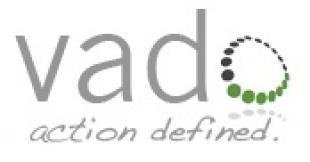Introducing Vado, Inc.
OpenSesame is excited to announce the addition of Vado Inc. courses to our elearning marketplace. Vado, Inc. co-founders Kim Egan and Cindy Pascale have arrived at unique conclusions about how to translate an organization’s desire to enable employees to improve their skills into real results. Both Kim and Cindy come from an HR background, one they feel perfectly marries with elearning success. “Good intentions become useless without thoughtful implementation,” Kim says. “We set out to eradicate this waste by developing a unique type of elearning course.”
“Managers want to engage, retain and develop their employees. They just sometimes don’t know what to do. There’s a big barrier between ‘wanting to do’ and ‘doing’. Kim and I set out to develop learning content to bridge that gap,” Cindy explains.
What is ‘scrap learning’?
They discovered that 70-80% of job-related development happens in the workplace. Employees were learning more by doing than they were by spending days in long workshops. This statistic implied an excess – ‘scrap learning’ – within company training initiatives. Scrap learning is training that has been delivered successfully but never applied. An astonishing 50-80% of workplace learning becomes scrap. Cindy laughs, “If any other business process were as inefficient as elearning development, they’d be out of business.”
Wait! Before you abandon your plans for an elearning program, understand that the success of such initiatives are variable depending on the buyer’s vision and the quality of purchased content. Kim and Cindy co-founded Vado, Inc. with the mission to compile their research to create an elearning courses that significantly minimize scrap learning. Here are Kim and Cindy’s guidelines for evaluating elearning courses:
Advice for Buyers
- Determine a clear, measurable goal. Organizations interested in elearning programs should align course content with their business goals. Once course buyers understand how an elearning program will benefit their organizations, they should consider their decision at a deeper level. For instance, some elearning courses on leadership delve into the more esoteric questions around leadership – what qualities make a great leader? The Vado Inc. Competency Development: Leadership bundle breaks leadership into implementable steps, including “Determining if your actions are consistent with your values”, and “Increasing your consistency between your actions and the company values”. Such clearly articulated goals, make it easy to gauge success.
Kim expounded on the topic, stating: “Buyers should ask themselves ‘What do I want my learner to be able to do when they’ve finished their course?’ If they just want employees to understand concepts, there are a variety of courses that can meet that need. But if you need employees to actually do something, you need to look at the courses you’re purchasing and make sure that the content translates into action.” The Vado Inc. co-founder warned that If a course does not appear to help learners implement what they’ve learned on the job, the chances of wasting money is very high. For this reason, Vado, Inc. provides downloadable job aids like templates and checklists to ensure follow through.
- Anticipate employee expectations. Be sure you understand what target learners are expecting from the course material, and what type of learning material is standard in your field. Seasoned wielders in their 40’s and 50’s will accept vastly different content than the marketing team at a fashion company. Cindy and Kim agree that just as websites have become cleaner with more white space in the past few years, simple is better in elearning content, too. Vado, Inc. focuses on superior content over flashy “clicky-clicky-bling-bling”, and keeps their video design crisp and very simple.
- Make it desirable. “People are either accountable for training – it’s mandatory – or they have to really want to grow, develop or improve. In order to foster that desire, you have to make your content compelling; make it desirable.” Kim describes this process by articulating a clear answer to the learner’s first question, what’s in it for me? “You don’t need a fancy title. Talk about results! Real results focus learner attention. They can easily see what’s in it for them.”
The Vado, Inc. Career Development bundle is a clear example of this. With just a quick look at the front page, learners are presented with a tantalizing menu of skills: “Learn how to brand and promote what you do”, “Identify potential career opportunities”, etc. Each modular step is labelled with an obvious value-add for the learner, making the somewhat nebulous topic of ‘career development’ concrete and easily attainable.
You can check out the Vado Inc. course and course bundle listing here.






